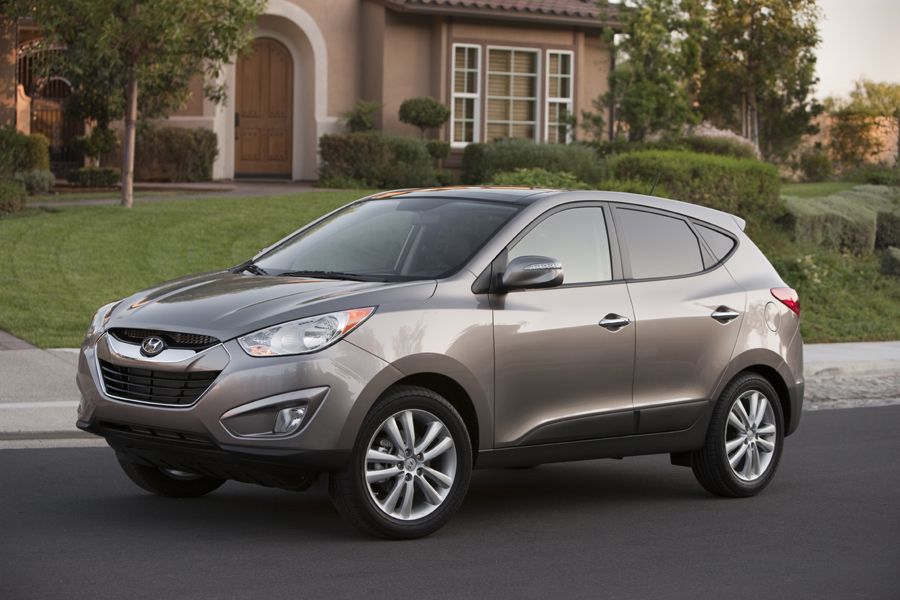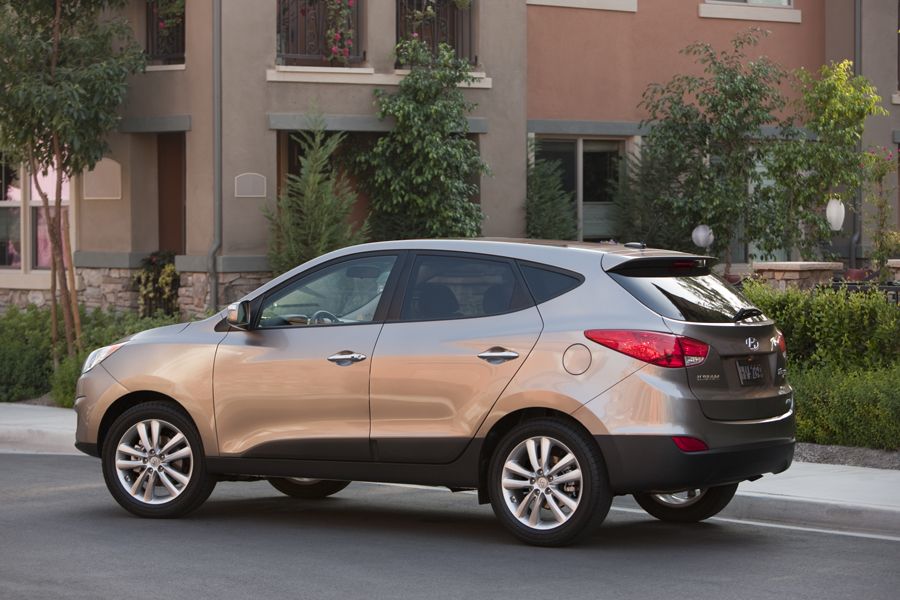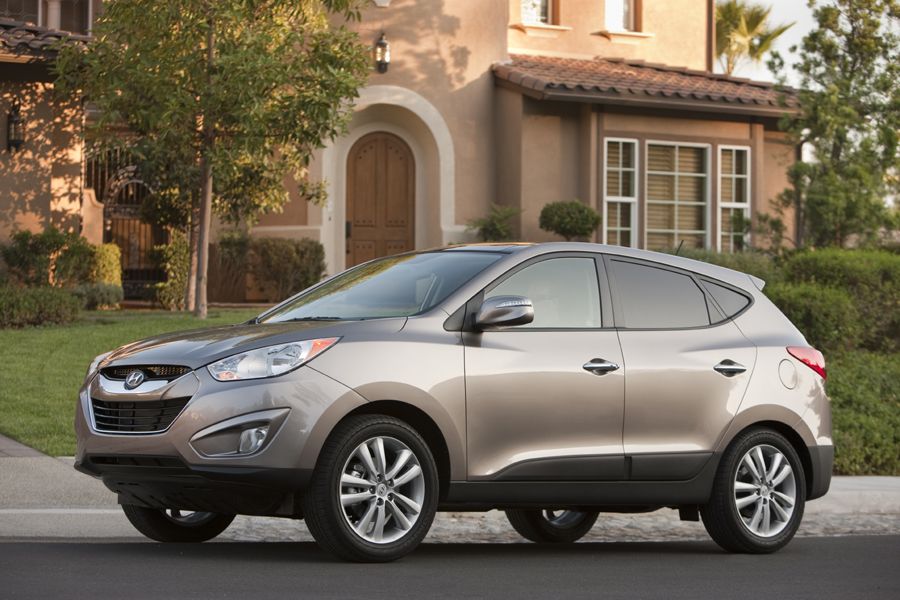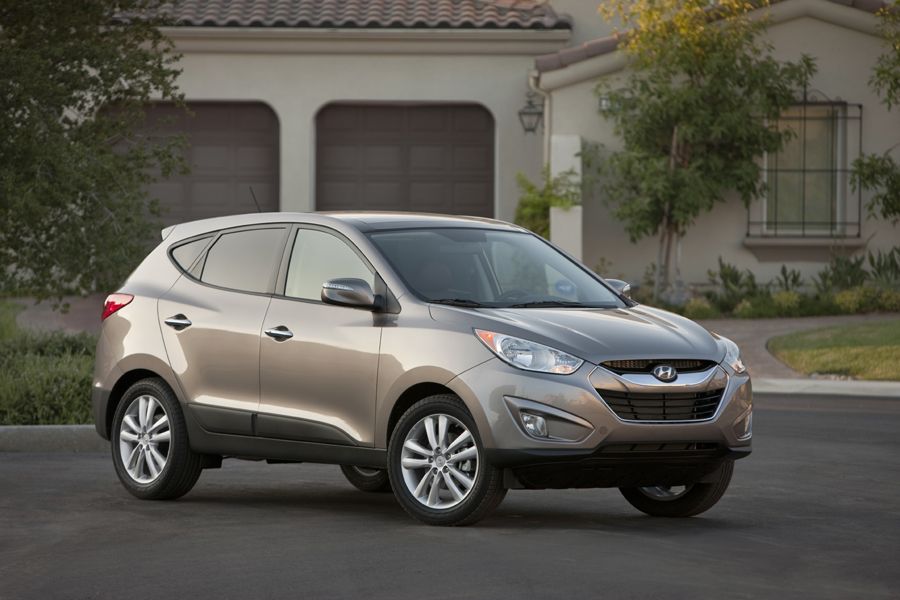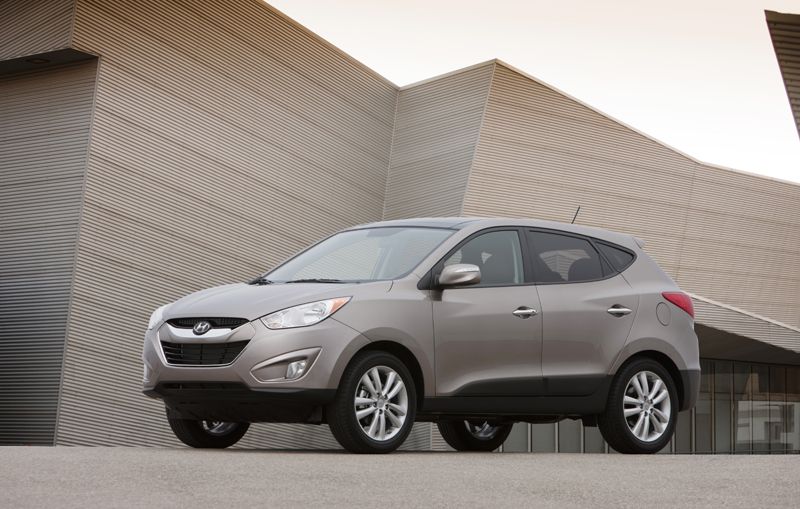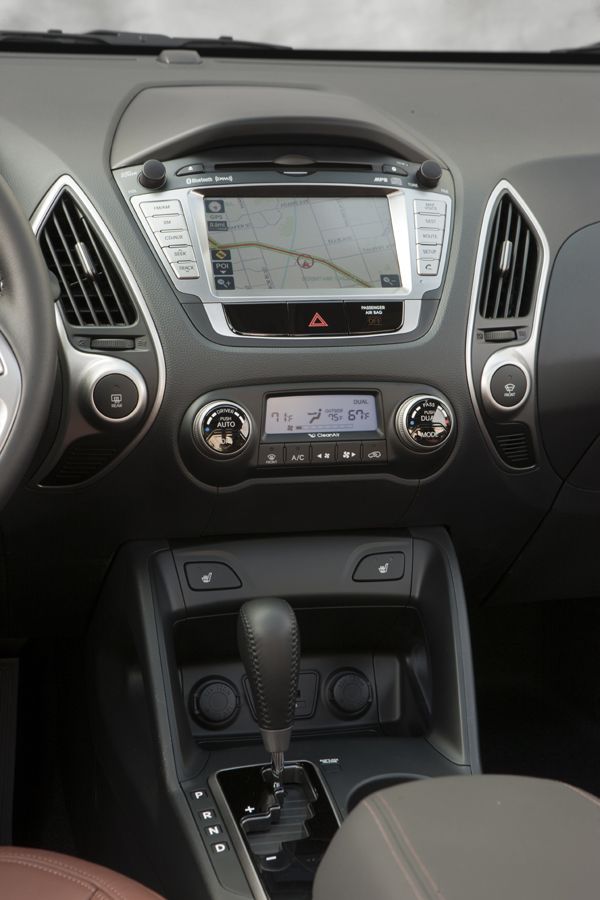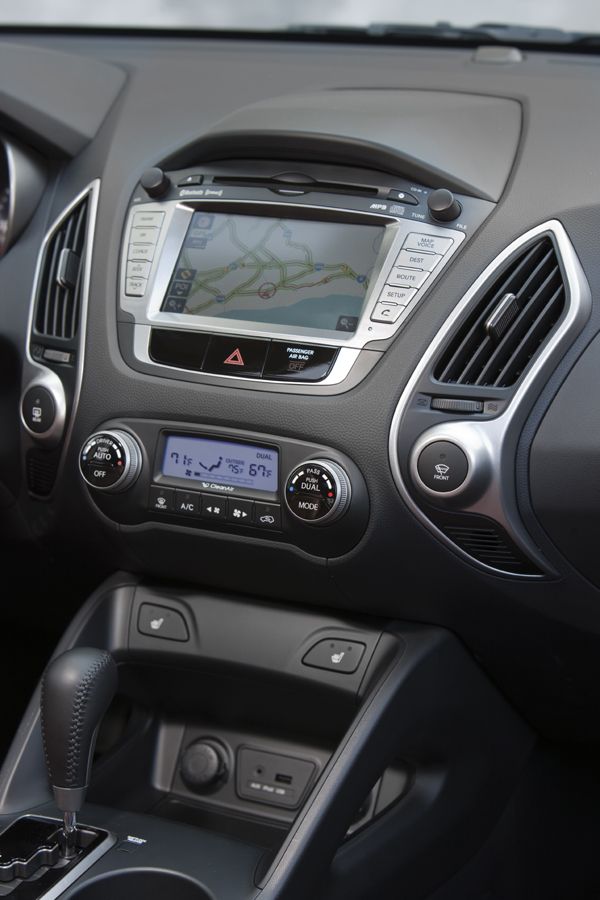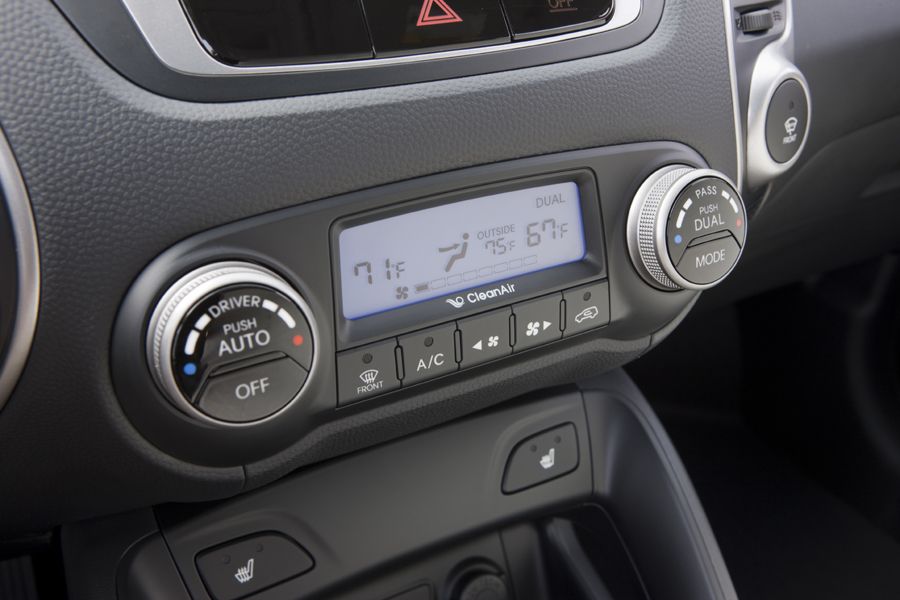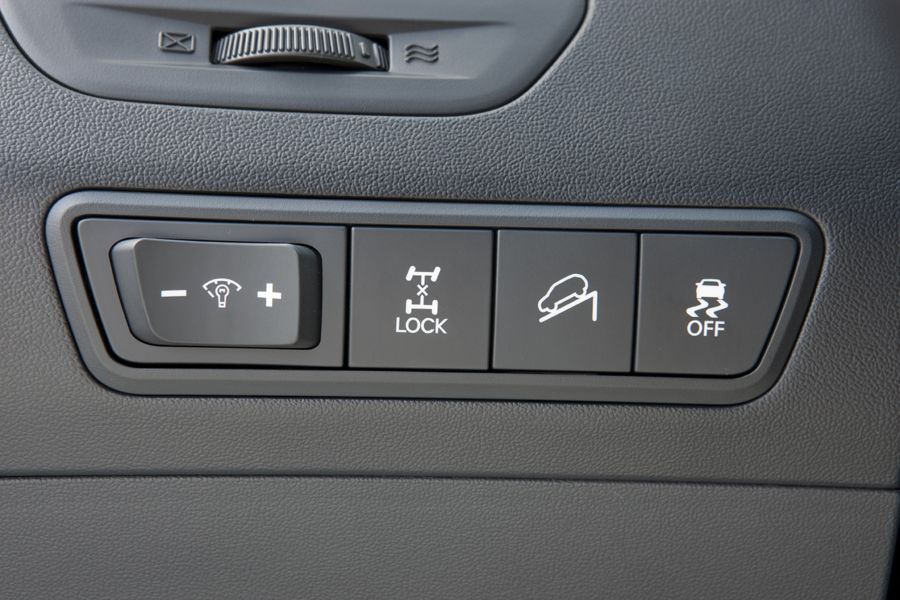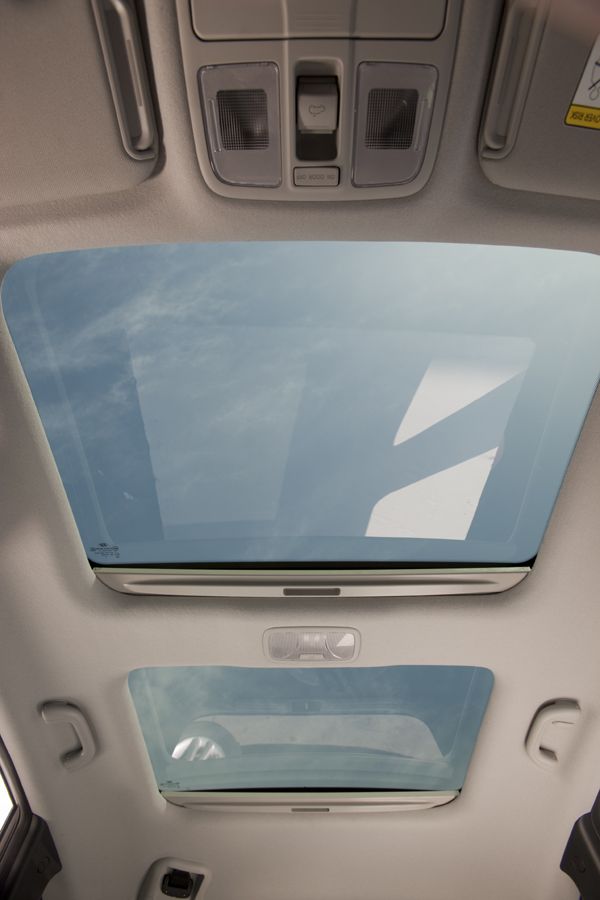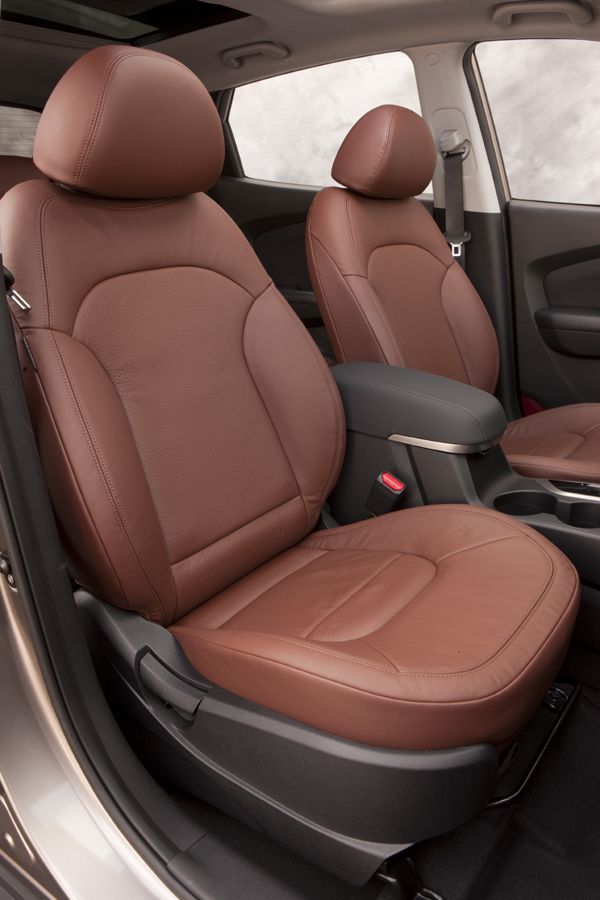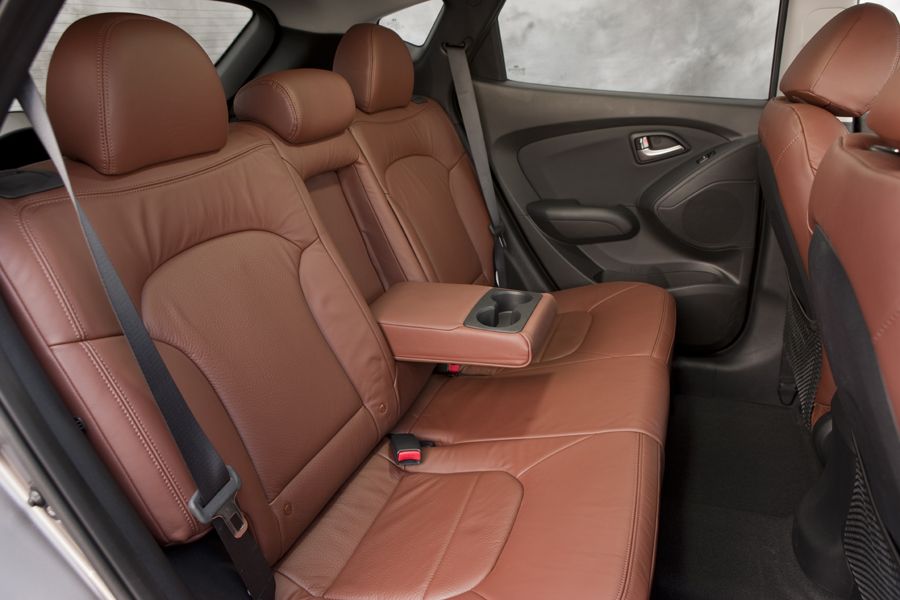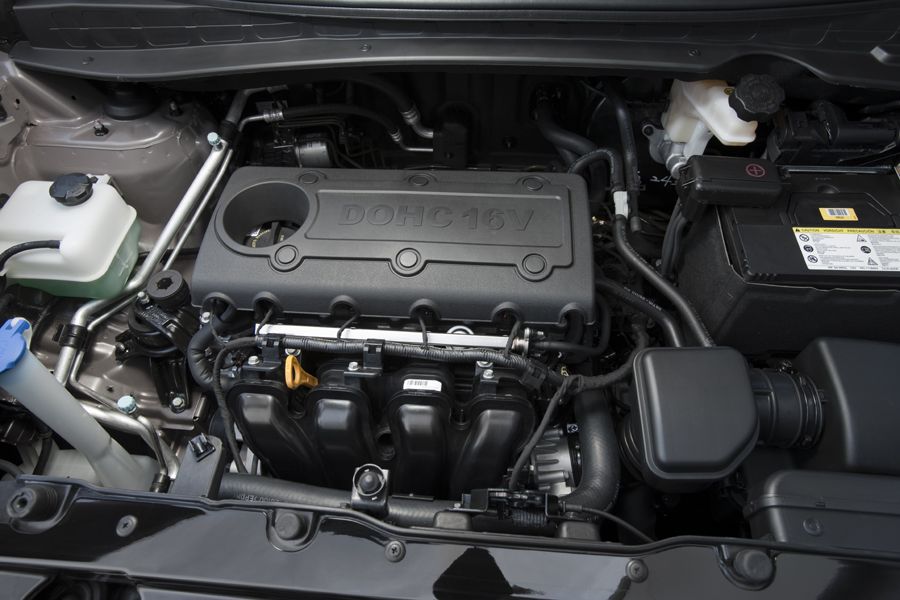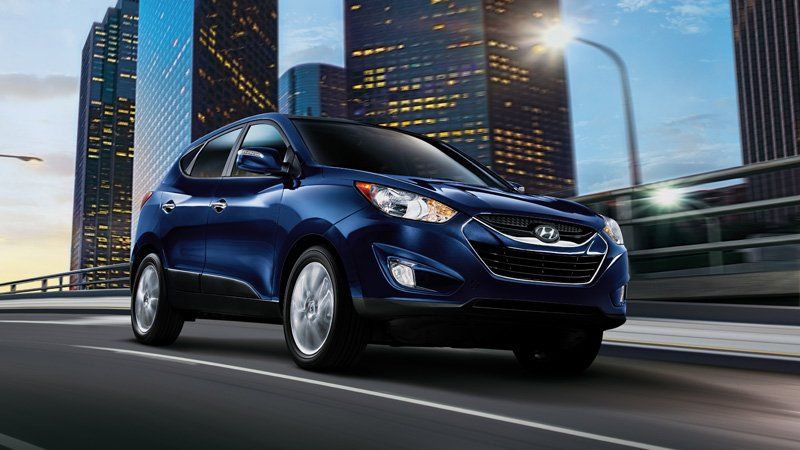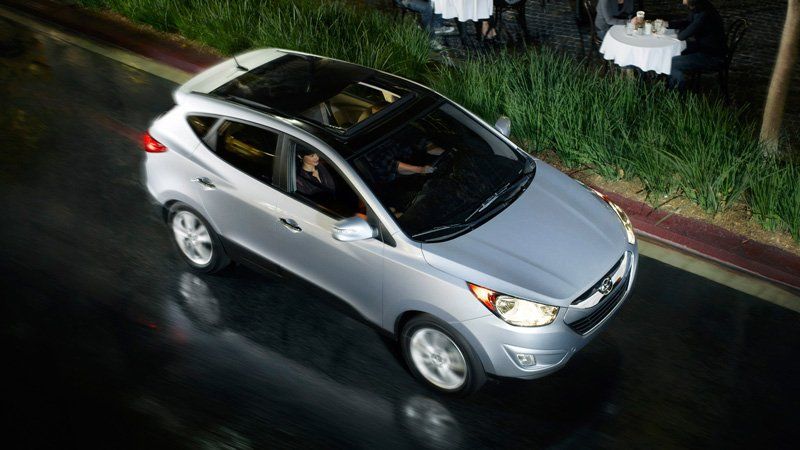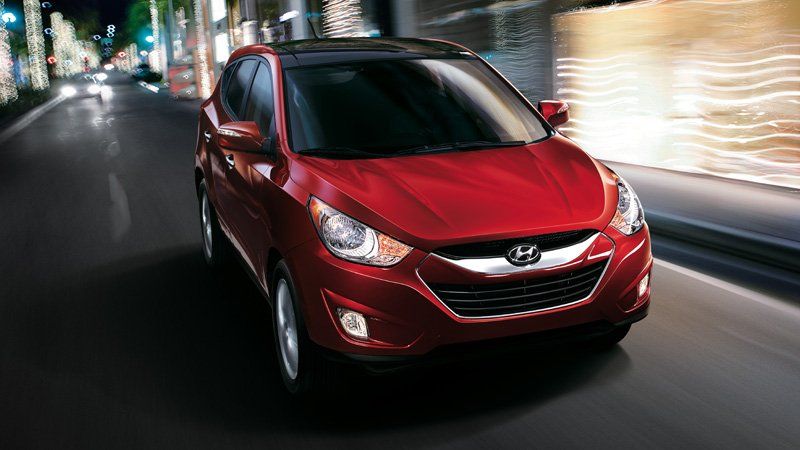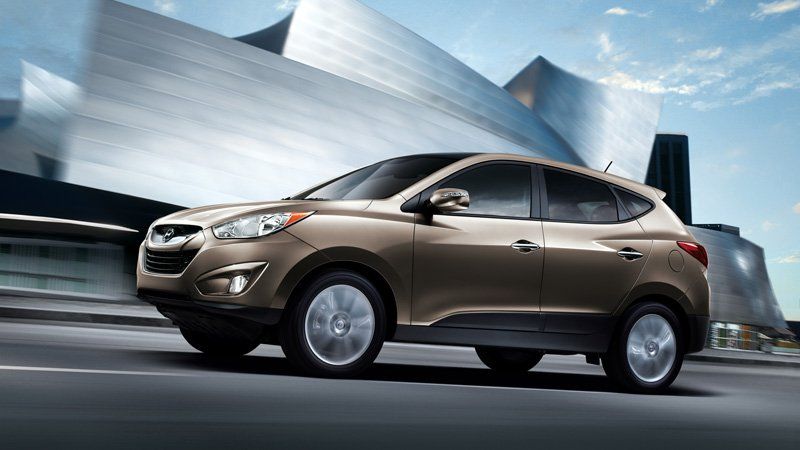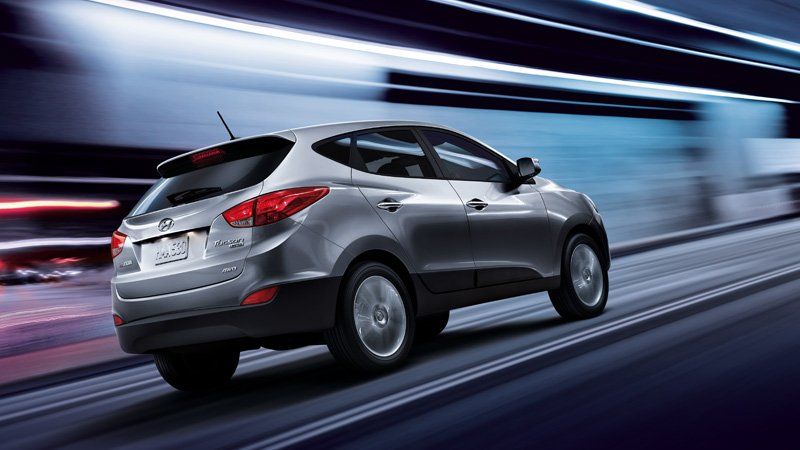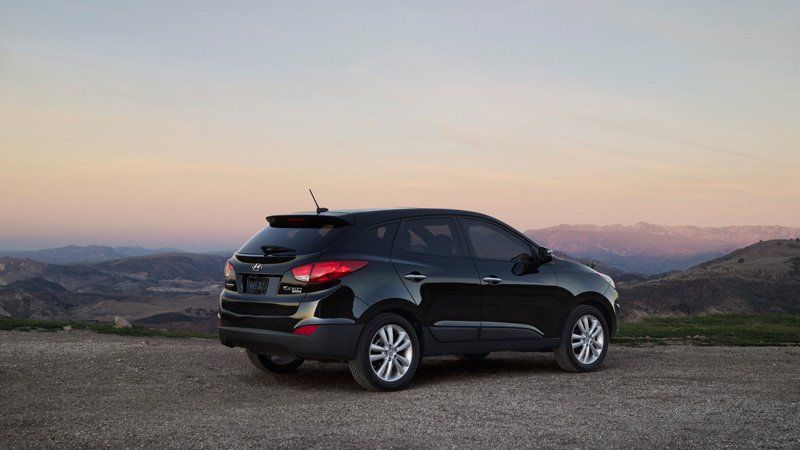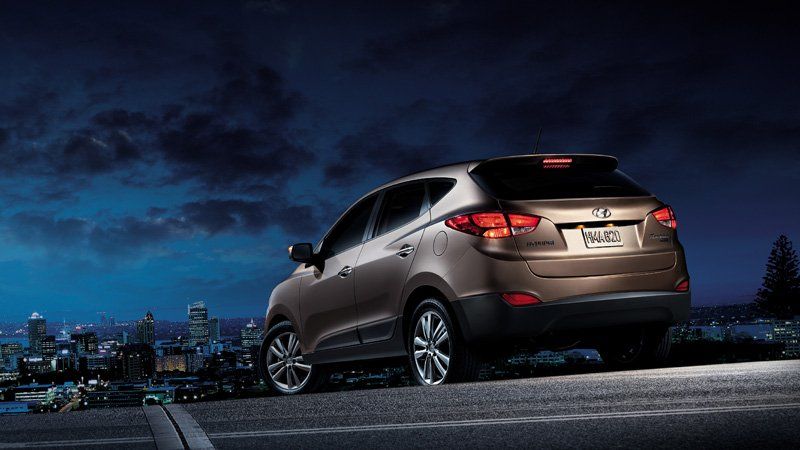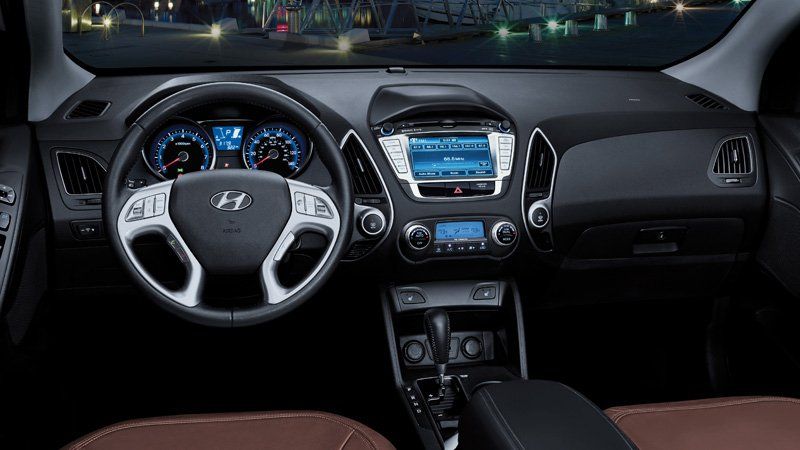At the 2009 Los Angeles Motor Show Hyundai unveiled a facelift version of the Tucson SUV, a model that will compete with entry level SUVs like the Honda CR-V, Toyota RAV-4 and Subaru Forester. The 2010 Tucson will be powered by the same Theta II GDI 2.4 Liter DOHC inline four cylinder engine that will be found under the hood of the 2011 Hyundai Sonata delivering a maximum output of 176 HP, 26% more than its predecessor, and 168 lb-ft of torque. The engine will be mated to either a six speed automatic with SHIFTRONIC manual control or a standard six speed manual transmission.
Following in line with Hyundai's Fluidic Sculpture design philosophy, the new Tuscon demonstrates athleticism and sophistication through its flowing lines, full bodied surfaces and muscular profile. Along with the overall appearance, the new Tuscon features details like Hyundai's new hexagonal front grill and swept back headlights complimented by a sleek greenhouse and wraparound taillights while chrome accents in the grill and door handles gives an added level of sophistication to the top of the line Tucson Limited. The Tuscon will range from $18,995 for a well equipped GLS six speed manually shifted model and go all the way up to $24,345 for a top of the line Limited model.
Press release after the jump.
2010 Hyundai Tucson
- Make: Array
- Model: 2010 Hyundai Tucson
- [do not use] Vehicle Model: Array
Press release
In 2010, a revolutionary new Tucson joins the rapidly evolving Hyundai product line. The sleek crossover from Hyundai, with its athletic European design, strikes a stark contrast from its predecessor and improves in every functional area, from its roomier cabin with extra cargo space to its leap in fuel economy and technology. Tucson features the company's "Fluidic Sculpture" design language and is the first vehicle in Hyundai's 24/7 version 2.0 product initiative (seven all-new models by the end of 2011).
European Design
Key attributes of Hyundai's Fluidic Sculpture design philosophy are the athleticism and sophistication that Tucson demonstrates through its flowing lines, full surfaces and muscular presence. This athletic design language is highlighted by bold, dynamic graphic elements such as the new Hyundai family hexagonal front grille, aggressive lower air intake, sculptured hood creases, swept back headlights, sleek greenhouse and wraparound taillights. Chrome grille accents and door handles lend sophistication to the top-of-the-line Tucson Limited.
Conceived in a global collaboration among Hyundai's U.S., Korean and European advanced product groups, with design execution led by the Frankfurt studio, the new Tucson was developed as an urban cruiser. It is tough and compact for life in the city, yet sleek and agile for out-of-town travel.
2010 Tucson 61 Pounds lighter than the outgoing model despite being three inches longer
- The 2010 Tucson is 3.3 inches longer and one inch wider than its predecessor, yet 61 pounds lighter
- 2010 Tucson has a longer wheelbase and overall width than CR-V, Escape and Forester to deliver more packing efficiency
- Body stiffness is 38 percent greater than Rogue
World-class weight efficiency was one of the program targets for the Tucson engineering team. In fact, the 2010 Tucson leads all of its competitors in weight efficiency. Hyundai engineers also targeted leadership in power-to-weight ratio. Having these targets paid huge dividends in both performance and fuel economy.
The Tucson's widespread use of high-strength steel provides increased strength at a lower body weight. High-strength steel allows the four-wheel independent suspension to work optimally. At 3,203 pounds for an automatic transmission model, the Tucson is lighter than its competitors, while offering more interior room than Rogue and Escape, with body-bending rigidity 38 percent higher than the Rogue. The Tucson owes its 31 mpg estimated EPA highway rating to its weight efficient unibody architecture.
FUN-TO-DRIVE
The 2010 Tucson's athletic shape is now complemented with more agile handling, responsive steering and improved body roll control. These enhancements make the new Tucson more fun-to-drive. Tucson uses MacPherson strut front and multi-link rear suspension systems for more precise wheel control and a smoother ride. All four wheels are controlled by coil springs and fade-resistant gas-charged dampers. Stabilizer bar diameters have also increased. The front suspension now has a new 25 mm hollow stabilizer bar to save weight versus the predecessors 21 mm solid stabilizer bar. The rear suspension has a new 18 mm solid stabilizer bar versus the predecessors 14 mm stabilizer bar. Larger stabilizer bars keep the vehicle very flat during cornering and help provide quick turn-in response.
Rack-and-pinion Motor-Driven Power Steering (MDPS) also contributes to the Tucson's nimble and refined handling dynamics while saving fuel and reducing interior noise.
Due to the suspension geometry and wider track width that enables greater turn angles, Tucson's turning circle is 34.7 feet - an advantage Tucson drivers will appreciate in their daily driving and parking. In fact, Tucson's turning diameter bests Honda CR-V and Toyota RAV4.
TUCSON DELIVERS BETTER FUEL ECONOMY THAN CR-V
The Tucson was engineered to be more fuel efficient than its predecessor and chief competitors like the Honda CR-V and Toyota RAV4. The 2010 Tucson accomplishes this while being 3.3 inches longer and one inch wider than its predecessor and having a longer wheelbase than Honda CR-V, Ford Escape and Subaru Forester
Tucson features the Theta II 2.4-liter DOHC inline four-cylinder engine. The Theta II engine delivers about the same amount of power and acceleration as its predecessor's V6 engine with 20 percent better fuel economy than the old four-cylinder engine. In fact, the Tucson is more fuel-efficient than Honda CRV, Nissan Rogue, Toyota RAV4 and Ford Escape four-cylinder engines boasting an impressive estimated 23 mpg city/31 mpg highway fuel economy rating with the available six-speed automatic transmission with SHIFTRONIC® and front wheel drive. Tucson features low rolling resistance silica tires to contribute to the 31 mpg highway. With AWD (All-Wheel Drive), Tucson delivers an estimated 21 mpg city/28 mpg highway exceeding the primary competitors AWD versions including Subaru Forester.
The Theta II is rated at 176 horsepower (26 percent more than its predecessor) and 168 lb.-ft. of torque. This high-tech, all-aluminum, 16-valve engine features Continuously Variable Valve Timing (CVVT) on both camshafts and a Variable Induction System (VIS) for better engine breathing. In the green states, the 2010 Tucson is certified as a Partial Zero Emission Vehicle (PZEV) which means it is as clean as a hybrid.
SIX-SPEED AUTOMATIC AND MANUAL TRANSMISSIONS
Hyundai's commitment to making the Tucson extremely fuel efficient continues with a six-speed automatic transmission with SHIFTRONIC® manual control or a standard six-speed manual transaxle.
Hyundai's all-new six-speed automatic transaxle helps the company meet its goals of improving fuel efficiency and reducing emissions. Shifts are silky-smooth with an option of manual control through the SHIFTRONIC feature. Designed for transverse engine applications in passenger cars and SUVs, the new compact transmission puts Hyundai into an elite class of auto manufacturers who have designed their own proprietary six-speed automatic transmissions. The strength of the design is its unique layout which makes it smaller, more compact and lighter than any other six-speed on the market today.
For the customer, the new six-speed delivers a performance edge. In this application (FWD/A/T), it helps bring a 24 percent gain in highway fuel economy (31 mpg versus 25 mpg in the '09).
Developed over a four-year period, this new six-speed automatic is 26.4 pounds lighter than Hyundai's five-speed. It also is 1.6 inches shorter and considerably simpler having 62 fewer parts, which is a key to increased durability, lighter weight and lower cost.
CAPABLE FOR OUT-OF-TOWN TRAVEL
To make the Tucson even more versatile, Hyundai engineers added an advanced electronic AWD system designed by JTEKT. The AWD system will automatically activate under any driving condition when needed, distributing the power equally and optimizing driving performance. Under normal driving, the system only distributes power to the front wheels thereby reducing fuel consumption. The system includes a driver-selectable AWD lock allowing for a 50/50 torque split between the front and rear wheels for off-road and very slippery conditions.
For even more driver control, the 2010 Tucson features Hyundai's first Hillstart Assist Control (HAC) and Downhill Brake Control (DBC). HAC is designed to minimize rolling backwards on steep ascents. By selecting the DBC switch, the Hydro-Electronic Control unit manages the wheel speed sensors, steering angle sensor and acceleration sensor to maintain control and speed on steep declines without having to use the brake.
Thoughtful Interior Design
The long wheelbase and generous width of the Tucson, combined with Hyundai's expertise in interior packaging, have produced an interior that delivers class-leading rear legroom and improved headroom. These improvements were accomplished while lowering the overall height of the vehicle. The Tucson now has more passenger volume than Rogue and Escape at 101.9 cubic feet. Tucson's cargo capacity is 13 percent greater than its predecessor. In fact, Tucson has more interior volume than Acura RDX, and more cargo volume than Infiniti FX. The spacious cabin on Tucson Limited is further enhanced for all passengers by Hyundai's first available panoramic sunroof with UV blocking. Finally, with the extra wheelbase length, Hyundai engineers were able to expand front seat tracks allowing taller drivers a comfortable seating position.
The high-tech cockpit comes standard with Hyundai's signature blue lighting, power windows, power door locks, fold-away mirrors and remote keyless entry with alarm and panic button. Bluetooth hands-free phone system with voice recognition and steering wheel audio and cruise controls are also available. Another premium feature in the Tucson Limited is a CleanAir Ionizer that automatically cleans the air when the heater or air conditioner is running.
Audiophiles will love Tucson's 160-watt AM/FM/XM/CD/MP3 audio system with six speakers. This system includes XM Satellite Radio® and iPod®/USB auxiliary inputs as standard equipment.
The 2010 Tucson can be further upgraded with an optional navigation system with rearview camera. Shifting into reverse automatically turns on the rear-view camera that provides a wide-angle view reducing the risk of accidents. This navigation system also provides Bluetooth streaming audio capability. This easy-to-use unit can be controlled via a 6.5-inch LCD touch-screen or voice-activation by headliner-mounted microphone. The voice recognition allows the user to control the navigation system, audio system and phone commands. The system comes matched with the 360-watt premium audio system that includes an external amplifier and subwoofer. It plays compact discs, accesses digital music files employing Bluetooth streaming audio or allows driver and passenger to access their personal listening devices through the iPod/USB/auxiliary inputs. Bluetooth audio wirelessly streams music from a phone to the audio system. And with a Bluetooth-enabled phone, a local restaurant can be called for reservations before plotting the route.
Advanced Standard Safety Technologies: PART OF HYUNDAI'S ASSURANCE COMMITMENT
The 2005 Tucson was the first Hyundai model to feature standard ESC (Electronic Stability Control) upon its launch in fall 2004. It was also the first vehicle under $20,000 with standard ESC and six airbags. The Tucson started Hyundai's approach to combining state-of-the-art safety and affordability and this approach lives on in the 2010 Tucson. The Tucson is loaded with life-saving standard safety features including ESC with traction control, six airbags and active front head restraints. Its braking system features four-wheel disc brakes controlled by an advanced four-channel ABS with Brake Assist and Electronic Brake-force Distribution (EBD).
Tucson's standard front-seat active head restraints help prevent whiplash by automatically reducing the space between a front occupant's head and the head restraint during certain rear collisions and are highly recommended by safety organizations such as the IIHS.
A total of six airbags are positioned in the Tucson's interior. Dual advanced frontal airbags are complemented by front seat-mounted side-impact airbags and roof-mounted side-curtain airbags with new rollover sensors that cover both the front and rear seat rows.
-----
Specifications
ENGINE
- Placement Tucson GLS/Limited
- Type DOHC with CVVT Inline 4-cylinder
- Materials Aluminum block and heads
- Displacement 2.4 liters
- Horsepower 176 @ 6,000 rpm; 170 @ 6,000 rpm – PZEV
- Torque 168 lb-ft @ 4,000 rpm; 163 lb-ft @ 4,000 rpm - PZEV
- Bore & Stroke 88 x 97 mm
- Valves per cylinder 4
TRANSMISSION
6-speed manual
- Gear ratios GLS
- First 3.267:1
- Second 1.794:1
- Third 1.542:1
- Fourth 1.176:1
- Fifth 0.974:1
- Sixth 0.828:1
- Reverse 3.416:1
- Final drive 5.071:1 (1,2,R) 3.737:1 (3-6)
SHIFTRONIC™ manual shift model (A/T only)
- Gear ratios GLS
- First 4.212:1
- Second 2.637:1
- Third 1.800:1
- Fourth 1.386:1
- Fifth 1.000:1
- Sixth 0.772:1
- Reverse 3.385:1
- Final drive 3.195:1
DRIVE SYSTEM
- FWD Front-wheel drive
- AWD All-wheel drive includes driver selectable AWD lock
SUSPENSION
- Front Independent MacPherson struts with coil springs, hydraulic shock absorbers and 23 mm stabilizer bar
- Rear Independent multi-link with coil springs, hydraulic shock absorbers and 16 mm stabilizer bar
STEERING
- Type Motor driven power steering (MDPS) rack and pinion steering, engine rpm sensing
- Overall Ratio 15.9:1
- Turns, lock to lock 2.96
- Turning circle 34.7 ft (curb to curb)
BRAKES/TIRES/WHEELS
Front
- Power-assisted TBD-in vented disc (FWD)
- Power-assisted TBD-in vented disc (AWD)
Rear
- Power-assisted TBD-in solid disc (FWD)
- Power-assisted TBD-in solid disc (AWD)
- ABS 4-wheel, 4-channel, 4-sensor with Electronic Stability Control (ESC) with Traction Control System (TCS)
Tires
- P225/60HR17 (GLS)
- P225/55HR18 (Limited))
Wheels
- 17 x 6.5J steel wheel with full-size wheel cover (GLS)
- 17 x 6.5J alloy wheel (Optional GLS)
- 18 x 6.5J alloy wheel (Limited)
EXTERIOR DIMENSIONS
- Wheelbase 103.9 in
- Overall length 173.2 in
- Overall width 71.7 in
- Overall height (without roof rails / with roof rails) 65.2 in / 66.3 in
- Tread Width 17-in. alloys (front/rear) 62.4 in / 62.4 in
- Overhang (front/rear) 34.3 in / 35.0 in
- Minimum Ground Clearance 6.7
- Coefficient of Drag (Cd) 0.37
- Roof rails load capacity 220.5 lbs
INTERIOR DIMENSIONS
- Head room
- Front 39.4 in
- Rear 39.1 in
- Leg room
- Front 42.1 in
- Rear 38.7 in
- Shoulder room
- Front 57.1 in
- Rear 55.1 in
- Hip room
- Front 55.5 in
- Rear 53.4 in
- EPA passenger volume 101.9 cubic ft
- EPA cargo volume 25.7 cubic ft. with rear seats up; 55.8 cubic ft. with rear seats folded down
-----
Prices and options
|
Model |
Engine |
Transmission |
2WD MSRP |
AWD MSRP |
|
GLS |
2.4-liter I4 |
Six-Speed M/T |
$18,995 |
- |
|
GLS |
2.4-liter I4 |
Six-Speed A/T |
$19,995 |
- |
|
GLS w/ Pop. Equip. Pkg. |
2.4-liter I4 |
Six-Speed A/T |
$21,695 |
$23,195 |
|
GLS w/ Navi. Pkg. |
2.4-liter I4 |
Six-Speed A/T |
$23,695 |
$25,195 |
|
Limited |
2.4-liter I4 |
Six-Speed A/T |
$24,345 |
$25,845 |
|
Limited w/ Premium Pkg. |
2.4-liter I4 |
Six-Speed A/T |
$27,195 |
$28,695 |
Packages
|
Package |
Description |
Price |
|
Popular equipment package (GLS std. equip. plus) |
|
|
$1,700 |
|
Navigation (includes Popular equipment package) |
|
|
$3,700 |
|
Premium Package |
|
|
$2,850 |
Options
|
First Aid Kit |
$20 |
|
Wheels locks |
$50 |
|
Mudguards |
$85 |
|
Cargo mat |
$95 |
|
Carpeted floor mats |
$100 |
-----
Competitors and press reviews
"While it isn't exactly overpowered when unraveling the sinuous canyons of Malibu, where we were introduced to the Tucson by Hyundai, the twin-cam four feels entirely adequate on normal roads, and its exertions are never thrashy or intrusive in nature. The transmission options are a six-speed manual and a six-speed automatic (with manual override) that was designed and developed in-house by Hyundai itself. Well, once you've built locomotives and ships, what's a gearbox here or there? We did not get to try out the one manual vehicle on Hyundai's introductory drive, but we can confirm that the compact new autobox performed seamlessly throughout, and we failed to mystify or discombobulate it in any way." (InsideLine)
"Obviously, the Tucson is not a Lotus Elise. And every reason why it's not (besides the blatantly obvious) is tied into Hyundai's quest for higher fuel economy. For instance, like the new Ford Taurus, the Tucson features electronic power steering. You can just go ahead and get used to this in most new vehicles, Hyundai or otherwise. Hyundai claims e-power steering adds three percent to a vehicle's MPG rating, and while the steering isn't bad, it's just different than a traditional hydraulic setup. How? It takes more effort to "crack" the wheel out of its on center position, meaning you initially have to put more muscle into turning the wheel and find yourself turning a degree or two more than you intended, especially at higher speeds. However, we got used to the sensation fairly quickly. We should also state that like with most new technologies in cars, the feel of electronic power steering will improve over time. In fact, Hyundai's toying with the idea of letting drivers select the amount of assist they want, though that's still further down the line." (AutoBlog)
"With the new engine/trans combo, the vehicle feels quicker and spryer, and has no trouble getting to or staying at freeway speeds. The transmission also has a manual mode (no paddles) with tap up/down shifting. The transmission sometimes had to work a little on grades, but putting it in manual mode on twisty mountain roads eliminated any hunting. However, the new electric power steering does feel a bit artificial and the suspension doesn't absorb enough of the impact of hitting a pothole." (MotorTrend)
Competitors
The 2010 Escape is offered with a choice of two engines: a 171-hp, 2.5-liter I-4 engine with Intake Variable Cam Timing (i-VCT) or an available 3.0-liter V-6 that produces 240 hp thanks to internal improvements and i-VCT. Prices for the 2010 Ford Escape start at $21,020.
The 2010 Honda CR-V is priced at $21,545. It gets a 2.4-liter 4-cylinder engine with 180 hp and 161 lb-ft.City/highway EPA-estimated fuel economy ratings increase to 21/28 miles per gallon1 (mpg) on 2WD models and 21/27 mpg1 on models equipped with Real Time 4WD - an increase of 1 mpg in both city and highway driving on all models.
The 2010 Rogue is available in two models, Rogue S and Rogue SL, each with a standard 170-hp 2.5-liter 4-cylinder engine, Nissan’s advanced Xtronic CVT, Vehicle Dynamic Control (VDC) and 4-wheel disc brakes with Anti-lock Braking System (ABS). For 2010, the Rogue SUV is priced as follows: Rogue S FWD $20,340; Rogue SL FWD $21,930; Rogue S AWD $21,540; Rogue SL AWD $23,130.
The 2010 RAV4 is offered in three distinct grades – Base, Sport and top-of-the-line Limited – and with a choice between the 2.5-liter four-cylinder or the V6 engine. The 2.5-liter engine produces 179 hp at 6,000 RPM, along with 172 lb.-ft. of torque at 4,000 RPM. The 3.5-liter V6 develops 269 hp at 6,200 RPM and 246 lb.-ft. of peak torque at 4,700 RPM. Prices for the 2010 Toyota RAv-$ start at $21,675.
Conclusion
While the small SUVs market is usually dominated by Toyota, Hyundai is ready to do something about this. And the 2010 Tucson is the proof for this. It features an aggressive exterior styling, a simple, yet pleasant interior and new, more fuel efficient engines.
Hyundai keeps it simple: only two trim levels, that come equipped with almost everything you might need from an SUV (there are only three additional package to choose from). The car was designed to offer a great fuel economy, but this doesn't mean you will not enjoy being behind the wheel.


